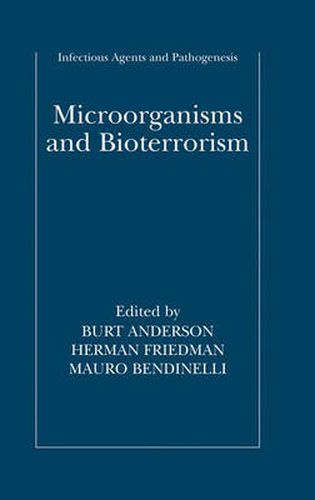Readings Newsletter
Become a Readings Member to make your shopping experience even easier.
Sign in or sign up for free!
You’re not far away from qualifying for FREE standard shipping within Australia
You’ve qualified for FREE standard shipping within Australia
The cart is loading…






This title is printed to order. This book may have been self-published. If so, we cannot guarantee the quality of the content. In the main most books will have gone through the editing process however some may not. We therefore suggest that you be aware of this before ordering this book. If in doubt check either the author or publisher’s details as we are unable to accept any returns unless they are faulty. Please contact us if you have any questions.
The threat of bioterrorism has become a major challenge for the twenty-?rst century. However, the potentials of infectious agents as bioweapons have been recognized for centuries. Throughout history there have been attempts to i- tiate infectious disease outbreaks and epidemics during warfare. In the last decade the attention of the biomedical community, as well as governments and the United Nations, has increasingly focused on the threat of bioterr- ism, especially the use of biological and/or chemical weapons against military and civilian populations. As an example, there is now much interest conce- ing microbial infection and bioterrorism in the medical microbiology and - munologycommunities. Thisvolumeaddressessuchconcernsandemphasizes bothbasicandclinicalconcepts,aswellasproblematicimplicationsofinfection by various microbes now recognized as potential bioterrorism agents. The ?rst chapter by Drs. Andrew Canons, Philip Amuso, and Burt And- son from the University of South Florida is an overview of the biotechnology of bioterrorismbothinthepublichealthresponsetopossibleactsofbioterrorism, aswellasfortheconcernsaboutthemisuseofbiotechnology. Thesecondch- ter is a historical perspective of microbial bioterrorism by Dr. Steven Morse, Director of the Bioterrorism Division at the Center for Disease Control and Prevention in Atlanta, GA. This chapter describes in detail historical aspects concerning the early use of biological agents in warfare, development and international conventions to prohibit the use of such weapons, and a brief - scription of important incidents of infectious agents as bioterrorist agents and use during the last few centuries. The next chapter by Dr. Sandra Gompf from the University of South Florida discusses the role of public health physicians and infectious diseases specialists in the control of microbial bioterrorism.
$9.00 standard shipping within Australia
FREE standard shipping within Australia for orders over $100.00
Express & International shipping calculated at checkout
This title is printed to order. This book may have been self-published. If so, we cannot guarantee the quality of the content. In the main most books will have gone through the editing process however some may not. We therefore suggest that you be aware of this before ordering this book. If in doubt check either the author or publisher’s details as we are unable to accept any returns unless they are faulty. Please contact us if you have any questions.
The threat of bioterrorism has become a major challenge for the twenty-?rst century. However, the potentials of infectious agents as bioweapons have been recognized for centuries. Throughout history there have been attempts to i- tiate infectious disease outbreaks and epidemics during warfare. In the last decade the attention of the biomedical community, as well as governments and the United Nations, has increasingly focused on the threat of bioterr- ism, especially the use of biological and/or chemical weapons against military and civilian populations. As an example, there is now much interest conce- ing microbial infection and bioterrorism in the medical microbiology and - munologycommunities. Thisvolumeaddressessuchconcernsandemphasizes bothbasicandclinicalconcepts,aswellasproblematicimplicationsofinfection by various microbes now recognized as potential bioterrorism agents. The ?rst chapter by Drs. Andrew Canons, Philip Amuso, and Burt And- son from the University of South Florida is an overview of the biotechnology of bioterrorismbothinthepublichealthresponsetopossibleactsofbioterrorism, aswellasfortheconcernsaboutthemisuseofbiotechnology. Thesecondch- ter is a historical perspective of microbial bioterrorism by Dr. Steven Morse, Director of the Bioterrorism Division at the Center for Disease Control and Prevention in Atlanta, GA. This chapter describes in detail historical aspects concerning the early use of biological agents in warfare, development and international conventions to prohibit the use of such weapons, and a brief - scription of important incidents of infectious agents as bioterrorist agents and use during the last few centuries. The next chapter by Dr. Sandra Gompf from the University of South Florida discusses the role of public health physicians and infectious diseases specialists in the control of microbial bioterrorism.